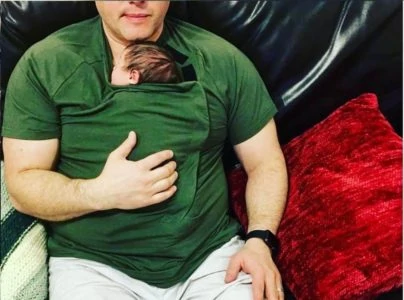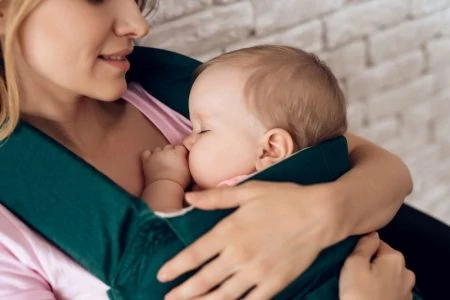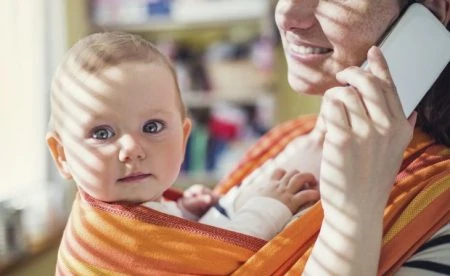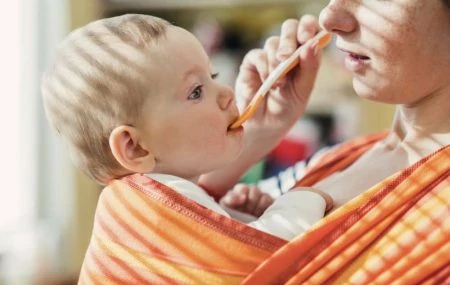Is your little one craning their neck to see the world? It might be time to switch things up.
As your baby grows, they often spend as much time straining to look around as they do snuggling into your chest. Naturally, you might be wondering when your baby can face forward in their carrier so they can see the sights.
In this article, we will discuss when it is safe to face your baby forward in their carrier and why some parents choose to skip this position entirely. We will also cover the essential safety precautions you need to take if you decide to make the leap.
Key Takeaways
- Forward-facing is generally safe once a baby has strong head and neck control, usually around 4 to 6 months.
- Risks of this position include overstimulation, hip dysplasia if positioned poorly, and positional asphyxiation if the baby sleeps.
- Always ensure your baby’s legs form an “M” shape with knees above hips to protect their joints.
- Never let a baby sleep facing outward; their airway can become compromised without head support.
When to Face Baby Forward
Babywearing is a bonding experience for you and your child. It is a convenient way to tackle your to-do list while giving your baby the skin-to-skin comfort they crave. However, curiosity eventually kicks in, and your baby will want to see the action. A forward-facing position can offer your child a front-row seat to the world.
Before you flip your baby around, you must ensure they have the muscle strength to stay safe. Your baby needs full head and neck control to face outward (1). This milestone typically happens between 4 and 6 months of age.
Always check your specific carrier’s manual. Manufacturers often list specific weight limits or developmental milestones your child must meet before using the outward-facing mode.
Cons of Facing Babies Forward
While letting your baby see the world is tempting, many parents and experts advise against it for long periods. Here are a few reasons why some parents avoid the forward-facing position.
1. Less Comfortable for You
When you wear your baby facing outward, you no longer share a center of gravity. Your baby’s weight pulls down and away from your body, which puts significant strain on your shoulders and lower back. Conversely, when your baby faces you, their body curves into yours, which distributes their weight more evenly.
2. Poor Positioning for Your Baby
The forward-facing position isn’t just tough on your back; it can be uncomfortable for your little one, too. Facing out often causes a baby’s back to arch (hollow), forcing their weight to sit entirely at the base of their spine rather than being supported along the back and thighs.
It is also harder to achieve the ergonomic “M” position, where the knees sit higher than the hips. Poor leg positioning can strain the hip sockets and potentially contribute to hip dysplasia (2).
3. Overstimulation Risk
Facing forward exposes your baby to everything happening around them with no “off” switch. Unlike facing you, where they can bury their face in your chest if they feel overwhelmed, facing out leaves them exposed to lights, noise, and strangers. This can quickly lead to an overstimulated, cranky baby.
4. Lack of Head and Neck Support
Forward-facing carriers do not provide head support. If a baby lacks total head control, their chin can drop toward their chest. This position can restrict their airway, leading to positional asphyxia.
Even older babies are at risk if they fall asleep in this position. Since there is nothing to lean their head against, their airway can become compromised the moment they doze off.
How to Forward Carry
Techniques for a forward-facing carry differ based on your gear. Below are instructions on how to forward carry with the most common carrier styles.
Forward Carry in a Sling
For ring slings, use the “Kangaroo Carry.” This style holds your baby facing outward in a pouch, similar to how a kangaroo holds her joey.
Here is how to execute the Kangaroo Carry in a sling:
- Thread your sling and place it over your shoulder.
- Open the top rail of the sling to create a wide carry basket.
- Hold both rings and pull the bottom rail to tighten the fabric sitting against your chest.
- Bring the material down to your mid-breast or lower, ensuring it is flat against your midsection.
- Tighten the bottom rail again if necessary.
- Place your baby with their back snugly against your chest.
- Fold your baby’s legs into a crossed “froggy” position, tuck them into the sling, and pull the top fabric up over their chest.
- Support your baby with one hand while using the other to tighten the top rail around them.
- If your baby sits too low, lift them with one hand and tighten the middle rail with the other to secure the seat.
Wrap It Up
Using a wrap looks intimidating, but it becomes second nature with practice. Note that stretchy wraps are generally not recommended for forward facing; woven wraps provide better support.
Follow these steps to forward carry in a wrap:
- Find the center of your wrap, place it on your stomach, and gather the fabric without twisting it.
- Take the two tail ends around your waist and cross them at your back.
- Bring the tail ends up over your shoulders so they hang down in front of you.
- Check that the fabric is not twisted and pull the stomach section to create a pouch.
- Hold your baby with their back against your chest and settle their bottom into the pouch.
- Ensure the baby’s knees are lifted toward their chest; their feet should remain outside the pouch.
- Tighten the bottom rail thread by thread, tucking the excess fabric deep under your baby’s rear to create a seat.
- Take the tail ends, bring them over your baby’s shoulders (optional, depending on tie style) or under their arms, and cross them under the baby’s legs.
- Bring the ends around to your back and tie a double knot to secure the wrap.
- Spread the fabric crossing under the legs to widen the seat for comfort.
- Perform a safety check to ensure legs are in the “M” position and the airway is clear.
Forward Carry in a Soft-Structured Carrier
This is often the easiest method, but you must ensure your carrier is specifically designed for it (like an Ergobaby 360 or similar).
Here is how to carry forward in a soft-structured carrier:
- Secure the waist belt around your hips and buckle it tight.
- Adjust the seat buttons or velcro tabs to the “narrow” or “forward-facing” setting if your carrier has them.
- Loosen the shoulder straps slightly to make entry easier.
- Pick up your baby and hold them against your body, facing out.
- Guide your baby’s legs through the leg openings on either side of the carrier body.
- Support your baby with one hand while slipping your arms through the shoulder straps.
- Buckle the chest clip (at the back of your neck) and tighten the shoulder straps until the baby is high and close.
- Check that your baby’s bottom is deep in the bucket seat and their knees are not dangling straight down.
Twist and Tuck Forward Carry
A Mei Tai (or Meh Dai) offers the structure of a carrier with the custom fit of a wrap. The “twist and tuck” is a simple variation for curious babies.
Follow these steps for the tuck-and-twist forward-facing carry:
- Tie the bottom straps of the Mei Tai securely around your waist.
- Sit down and place your baby on your lap, facing away from you, with their back against your chest.
- Lift your baby’s knees into a crossed or squatting position.
- Pull the body panel up over the baby’s tummy and bring the shoulder straps over your shoulders.
- Stand up while supporting your baby; reach back to grab both straps.
- Pull down to tighten, then cross the straps behind your back.
- Bring the straps to the front, cross them *over* the baby’s legs (or under, depending on size), and twist or knot appropriately to secure the seat.
- Tie the final knot behind your back.
What Are Your Options?
Not all carriers are created equal. Here are the different types of gear and how they handle the forward-facing position.
1. Soft-Structured Carriers (SSCs)
These are the “backpack style” carriers with padded straps and buckles. They are user-friendly and require no complex tying.
Many modern SSCs are explicitly designed with ergonomic bucket seats that adjust for forward-facing. They are generally the safest bet for maintaining good hip positioning while facing out.
2. Wraps
Baby wraps are long pieces of fabric that tie around your body.
Stretchy Wraps: These are great for newborns but are generally unsafe for forward-facing. The fabric is too elastic to support the weight of an older, forward-leaning baby, which can lead to slumping.
Woven Wraps: Made of rigid, non-stretchy fabric, these are excellent for all positions (front, hip, back). They require a learning curve but offer superior support for heavier babies facing out.
3. Mei Tai (Meh Dai)
Mei Tais are hybrids. They have a square body panel like an SSC but use long fabric straps to tie like a wrap. They are versatile and can be modified easily to narrow the seat for a forward-facing child.
4. Ring Slings
A ring sling is a single length of fabric secured with two rings. They are quick to put on and great for short “ups and downs.” While you can do a forward-facing kangaroo carry, many parents find a hip carry offers the baby the same view while keeping them in a more ergonomic, parent-facing position.
Common Troubleshooting & Safety
We have covered the “how-to,” but safety is paramount. Here are answers to common concerns regarding facing your baby forward.
1. Baby’s Head Keeps Leaning Forward
If your baby’s head lolls forward, they likely do not have the neck strength required for this position. Turn them back to face you immediately.
This is critical: if a baby’s chin touches their chest, it can crimp their windpipe and restrict breathing. Wait a few more weeks and try again when their neck is stronger.
2. What Is the Correct Leg Position?
To protect the hips, your baby’s legs should form an “M” shape. This means their bottom is lower than their knees.
In a soft-structured carrier, you may need to adjust the seat width buttons. In a wrap or sling, you must perform a “pelvic tuck” by scooping the baby’s bottom forward and ensuring the fabric supports their thighs from knee to knee.
3. Can Babies Sleep Facing Forward?
No. Your baby should never sleep facing outward. This position puts them at high risk of positional asphyxiation.
Remember
FAQs
In Conclusion
Babywearing is a journey that changes as your baby grows. While facing forward is a fun milestone that lets your little explorer see the sights, safety must always come first.Wait for that solid head control, watch those hips, and keep an eye on their mood to avoid overstimulation. If they get fussy or sleepy, simply turn them back around for a cuddle. Trust your instincts, Mama, you know what is best for your baby.










